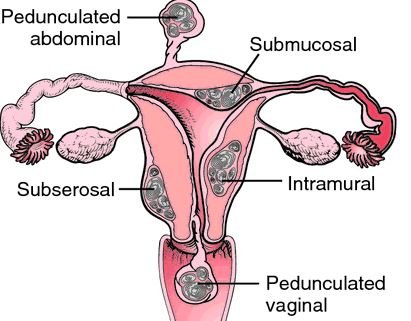Leiomyomas of the Uterus
What are Uterine Leiomyomas?
Uterine leiomyomas or myomas are also known as uterine fibroids. These are benign tumors that arise due to the excessive growth of connective tissue and smooth muscle in the uterus.

There is a single cell that divides again and again that creates a rubbery mass after some time that might be different from a tissue close by. The growth patterns of these uterine leiomyomas differ; it’s either they grow fast or slowly, or the size stays as it is. Some even undergoes through growth spurts while others somehow shrink on their own.
A lot of fibroids that had existed during pregnancy vanish or shrink after giving birth, as the uterus returns to how it was before in its normal size. Uterine leiomyomas vary in size from seedlings that are not visible by the eyes of an individual, to large masses that can disfigure and enlarge the uterus.
The fibroids can be multiple or single and in worse cases, the uterus becomes enlarged so much that it stretches out to the rib cage. They commonly appear through the years of childbearing and are not linked with any risks of uterine cancer and almost never unfold into cancer.
What are the Symptoms of Uterine Leiomyomas?
Uterine leiomyomas generally occurs in about 25% of the female population and are most commonly observed in Africa.
A lot of women are not even aware throughout their lives that they have uterine fibroids, but mostly they are oblivious of them because they presented no symptoms at all. The size, number, and location of the fibroid also have an effect of the signs and symptoms.
If symptoms occur, the most common are:
- Pain in the back or leg pains
- Pain or pressure on the pelvis
- Excessive menstrual bleeding
- Constipation
- Frequent urination
- Extended menstrual periods wherein it lasts for seven days or more of bleeding
- Trouble emptying the bladder
In rare cases, a fibroid can cause severe pain when the blood supply is outgrown. The fibroids begin to die off once the nutrients are deficient and the deteriorated fibroid can leak into other tissues nearby causing pain and sometimes fever.
A fibroid that dangles by a stalk outside or inside of the uterus can elicit pain by trimming off the supply of blood and wringing on its stalk.
See a physician if any of these symptoms occur:
- Regular pain during intercourse
- Pain in the pelvic that does not subside
- Having a hard time urinating
- Enlargement of the abdomen and uterus
- Painful or heavy periods
- Spotting in the midst of periods
Diagnosis & Radiology
Uterine leiomyomas are often found by chance during a pelvic exam. The physician might feel unevenness in the shape of the uterus indicating that the fibroids are there. If symptoms are present, the tests that could be performed include:
- Laboratory tests – If the bleeding of the vagina is not normal anymore, the physician will investigate the causes. CBC or complete blood count and other blood tests may be executed.
- Ultrasound – This is to confirm the diagnosis then measure and locate the fibroids. Images of the uterus are taken.
Radiology:
- Hysterosonography – This test makes use of sterile saline to enlarge the uterine cavity and taking images of it and the endometrium.
- Magnetic resonance imaging – The test helps determine the best treatment and identify types of tumors, its location and size.
- Hysteroscopy – A tiny telescope referred to as hysteroscope is used to check the fallopian tube openings and the walls of the uterine cavity.
- Hysterosalpingography – This test uses a dye to emphasize the fallopian tubes and cavity on X-rays. The physician usually proposes it especially if it involves infertility.
How are Leiomyomas of the Uterus Treated?
No single treatment best suits in treating uterine leiomyomas but there are numerous of options. Treatment options for uterine fibroids include:
- Watchful Waiting – For women who experience no symptoms.
- Medications – This does not get rid of fibroids but they could shrink them.
- Myomectomy – This to protect fertility and it is done by removing the tumors through surgery.
- Hysteroscopy – The tumor is cut out by simply using a telescope on the uterine cavity.
- GnRH Agonist Therapy – It lessens the risk of oocyte loss and conserves ovarian function.
- Hysterectomy – The entire uterus is removed through surgery.
References:
- http://www.mayoclinic.org/diseases-conditions/uterine-fibroids/basics/definition/con-20037901
- http://www.ivf.com/fibroid.html
- http://radiopaedia.org/articles/uterine-leiomyoma
- Beck, M. M.; Biswas, B.; d’Souza, A.; Kumar, R. (2012). “Benign metastasising leiomyoma after hysterectomy and bilateral salpingo-oophorectomy”. Hong Kong medical journal = Xianggang yi xue za zhi / Hong Kong Academy of Medicine 18 (2): 153–155.
- McDonald, A. G.; Cin, P. D.; Ganguly, A.; Campbell, S.; Imai, Y.; Rosenberg, A. E.; Oliva, E. (2011). “Liposarcoma Arising in Uterine Lipoleiomyoma”. The American Journal of Surgical Pathology 35 (2): 221–227.
- Pedeutour, F.; Quade, B. J.; Sornberger, K.; Tallini, G.; Ligon, A. H.; Weremowicz, S.; Morton, C. C. (2000). “Dysregulation ofHMGIC in a uterine lipoleiomyoma with a complex rearrangement including chromosomes 7, 12, and 14”. Genes, Chromosomes and Cancer 27 (2): 209–215.
